Improving Defensive Semi Automatic Handgun skills
Posted by Mandu Moses on Mar 1st 2024
- Short or Long Sight Radius: Your distance from the target can easily impact how you hit it. If the sight radius is long, factors like wind can affect the movement of the bullet; hence, missing the target.
- Unstable Shooting Platform: An unstable shooting platform can impact the grip tension, leading to inaccuracy. Unlike long guns that have bone-on-bone support, handguns only depend on the support of the extended arms. This, coupled with a shaky shooting platform, can lead to instability. As a result, you can easily miss the target if a slight unintended movement occurs.
- Trigger Control: The weight of the gun and the trigger pull significantly affect how perfectly you can hit the target. When dealing with a semi-automatic handgun whose trigger pull is more than its weight, you will need to exert enough pressure on the trigger to get a targeted shot. Trigger control also has a lot to do with trigger actions.
- The Dreaded Flinch: You should know about muzzle blast and gun recoil to understand what happens when you fire a semi-automatic handgun. Muzzle blasts come as muzzle flashes and noise, which can affect your sight and focus. On the other hand, recoil is the back and upward movement of the gun after firing. All these can cause anticipation and impact your accuracy.
Accuracy
Power
Speed
Mindset
Marksmanship
Gun handling
- Start with developing a defensive mindset. Train your mind to adjust quickly in any situation. Once you have the survival mindset, bring in the tactics to defend yourself.
- Establish the power and know how many handguns you can control. This includes understanding the muzzle blast and recoil of your handgun.
- Learn about gun handling. Learn to handle and maintain your handgun even before you begin firing it. This ensures your gun is ready for any situation.
- Develop your marksmanship. Here, you focus on how to improve your sight alignment and trigger control.
- Improve your accuracy and speed. The last step involves learning how to balance accuracy and speed when shooting from different sight radiuses. The step also teaches you how to transition from target to target faster and more efficiently regardless of the position.
Most people believe that handgun accuracy is what determines their self-defense skills. However, professional gun handlers argue that defensive handgun skills have a lot to do with six primary shooting aspects. These are accuracy, speed, power, mindset, marksmanship, and gun handling. So, how do you incorporate all these into one shooting moment?
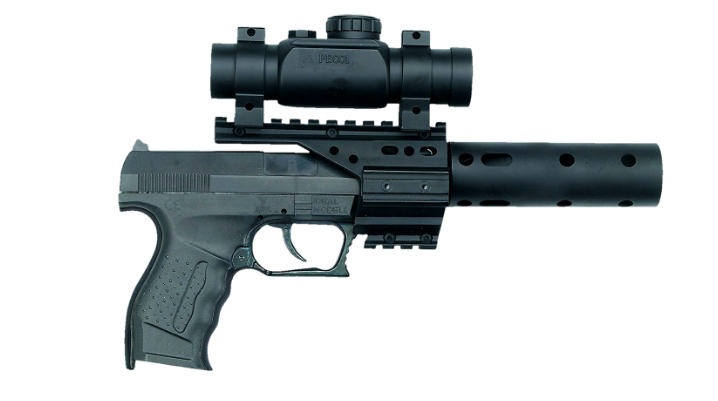
Image by Ralph
Anyone can easily manipulate other gun types like rifles and balance all the six shooting aspects. It only becomes challenging when dealing with semi-automatic handguns. For instance, long guns have shoulder anchors, grips, and forearms that can act as bipods.
On the contrary, handguns only hang at the end of the stretched arms, with a bunch of external factors that can affect their target. You also need to consider all the moving variables and focus on the target to get the perfect shot when using a handgun. Therefore, you need to learn about the two golden triangular shooting concepts as discussed herein to improve your defensive skills.
Shortfalls of Mastering Handgun Defensive Skills
Improving your handgun shooting skills starts with understanding the root cause of poor target hitting. A semi-automatic handgun is a must-have self-defense weapon that anyone strives to have. However, it comes with a set of shortfalls that can impact its purpose, leading to low accuracy and speed.
Therefore, any gun enthusiast should learn to maneuver through and overcome the following challenges to get a perfect handgun shot.
Understanding The Two Triangular Shooting Concepts
Jeff Cooper codified two triangular concepts that all gun students should master to overcome the above challenges. Most gun students believe that some training can give them the desired shooting skills. However, according to Jeff Cooper, the only way to gain effective self-defense skills is to understand each element in the two triangular concepts.
You can execute the two triangles independently during your training session. But you will need to apply the two concepts altogether to gain the desired weapon skill and remain safe in life-threatening situations. The two triads are:
1. The DVC Triad
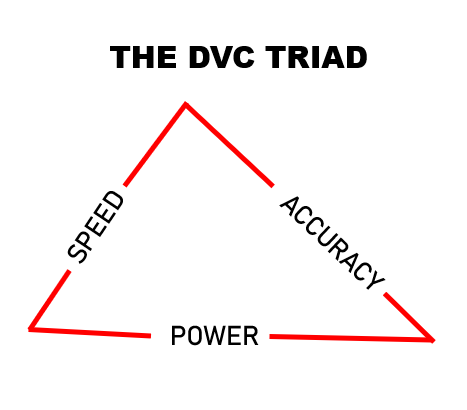
Diligentia, Vis, Celeritas (DVC), Latin for accuracy, power, and speed, is the motto of the first Gunsite and IPSC(International Practical Shooting Confederation) triad. Although the three elements form the basis of the triad, they are not equally important. That means you can focus on one or two elements at a time and still attain perfect shots.
That, however, does not mean you can overlook the importance of each element. Since the triad does not represent an equilateral triangle, it is upon you to balance the elements depending on the situation. Therefore, to manipulate the triad easily, here is what it says about each element:
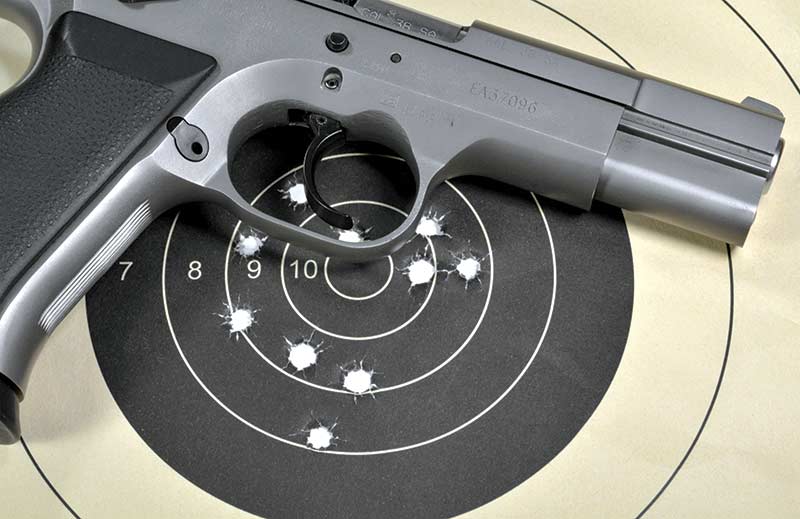
Semi-automatic handguns have different levels of precision depending on the ammunition and trigger actions. Also, while most people confuse precision with accuracy, the key difference lies in the sight radius.
For instance, precision is how close you can place the bullets to the same point every time you fire. To get the best precision with most defensive handguns, you should place all the bullets inside a 2-inch circle at 10 yards.
Accuracy, on the other hand, is how well you can attain the desired precision and place all the bullets at the same point. Gun type and ammunition are the primary factors that impact accuracy. However, your shooting abilities or marksmanship can also determine how well you manipulate the gun and achieve the desired precision.
A standard accuracy for most defensive semi-automatic handguns is to keep all bullets in a 2-inch circle at 5 yards.
Most competitive combat shooters calculate the power factor by multiplying the weight of the bullet in grams by its muzzle velocity in feet per second. They then divide the result by 1000.

Alternatively, they can determine the power factor by looking at the muzzle energy indicated on the ammunition box.
To get the desired handgun power factor, you also need to balance the power you hit the target with and the recoil of the gun. However, this does not guarantee your survival in lethal situations if speed is not applied. Therefore, you may want a gun with a higher power factor or muzzle energy and learn to fire multiple shots with utmost precision for the best bullet performance.
Your survival in lethal encounters depends on how fast you can draw your handgun from the holster and deliver an accurate shot. Sometimes, your life also depends on how fast and accurately you can deliver multiple shots without missing the target. Although speed is a myth to many shooting students, it appears in almost all combat competitions, especially alongside power.
Accuracy is paramount to most people, but having speed is fine. However, according to combat shooting professionals, gun handlers should first learn to draw their weapons faster from their concealment and fire to survive. For example, they should try and hit their target at a 5-yard circle with 2.5 seconds.
Building the DVC triad
Power is always the base in any situation because it is the only fixed element of the triad. That is because the power factor determines how effectively you can manage the gun depending on the handgun style and cartridge size. It is also the product of the gun and load, and the speed at which you deliver a hit.
Accuracy and speed vary in positions depending on the lethality of the situation. For example, if a threat appears suddenly at a close range, you will need to draw the gun faster and deliver an accurate shot. However, accuracy becomes more important if you are at the far end of the sight radius and need to hit the target with only one bullet.
2. The Combat Triad
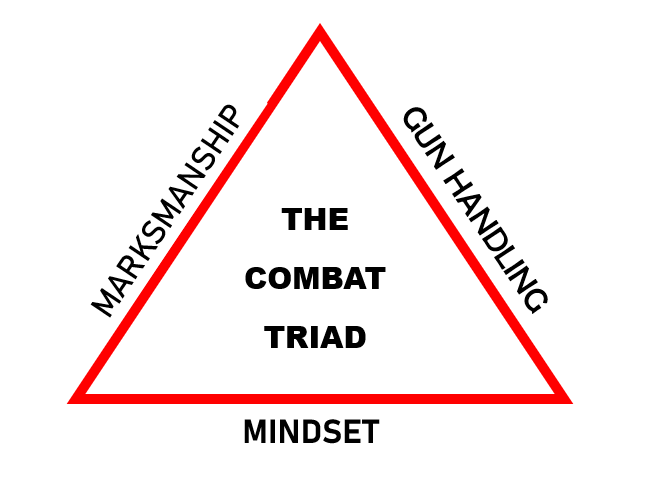
The combat triad is more of an equilateral triangle. That means, unlike the DVC triad, each element of the Combat triad has an equal significance on the triangle. Their support for each other does not also change regardless of the situation.
The Combat triad also forms the basis of the handgun's defensive skills. Therefore, you need to master this triangle before moving to the DVC triad. The elements of the triad are.
The mindset element consists of survival and tactics.
When a sudden lethal situation appears, your first reaction is the readiness to fight as if it is the only solution. That means you must train your mind to draw the weapon and deliver as much force as possible to your threat in order to live. That is where the survival part functions.
After withdrawing the weapon, this is where the tactics part kicks in. Here, you have to know when and how to use the weapon. You will also need to know when to take cover, shoot, or even move in some situations.
Generally, the mindset element is all about what you do when you encounter a self-defense situation. It trains you to be ready for any danger instead of getting caught unaware.
Marksmanship is all about knowing when, where, and how to shoot and salvage the situation. Although most people seek accuracy when dealing with semi-automatic handguns, it is not the only thing that determines one’s marksmanship. You must know how to play with different sight radiuses, lighting conditions, and targets and get the same accuracy.
Delivering bullets at the same point while standing is not enough. You need to go further and hit the same point while in different positions and under varied external factors. This way, you can easily build your marksmanship skills.

This is probably the most underrated element in Combat Triad and weaponcraft. Most gun instructors also focus on how to create other elements and forget to train their students how to handle individual gun types. However, knowing how to safely, efficiently, and swiftly manipulate a handgun in your hand is the ultimate way to survive any situation.
Proper gun handling includes how you take it out of concealment, load, unload, and keep it firing. It also includes how you maintain it through proper storage and cleaning. Without all these, it means your handgun will not work and may not save you in times of need.
Combining The Two Triangles
For you to improve your defensive semi-automatic handgun skills, you need to learn how to combine the two triads. This includes knowing which element should come first when facing a lethal situation.
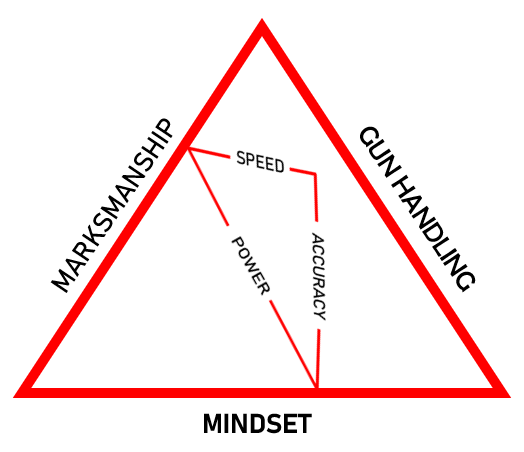
Here are the brief steps on how to build the triangles and improve your self-defense handgun skills:
Conclusion
Carrying your handgun around for self-defense purposes is one thing, but learning how to run that handgun and use it safely, legally, and accurately is an entirely different thing. You can easily draw your gun and pull the trigger. However, sometimes saving yourself may not be possible if you do not know how to manipulate the gun.
Luckily, mastering the two triangular concepts discussed above can easily improve your defensive skills and save you in any lethal situation. Just remember to make mindset the base element of the combined triangle and end your tactical training with accuracy and speed.
Give us a shout-out in the comments below if you feel enlightened about improving your defensive semi-automatic handgun skills.
